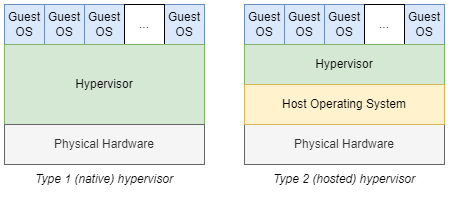Difference between revisions of "Hypervisor"
From Computer History Wiki
m (+cat) |
(examples of Type 1 vs Type 2 hypervisors + diagram) |
||
| Line 1: | Line 1: | ||
A '''hypervisor''' is a [[software]] package which provides [[virtual machine]]s. | A '''hypervisor''' is a [[software]] package which provides [[virtual machine]]s. | ||
| − | There are two main types: 'native' hypervisors, which are [[operating system]]s which run directly on the bare machine | + | There are two main types of hypervisors, classified by their level of abstraction from the physical hardware: |
| + | * Type 1 - 'native' hypervisors, which are [[operating system]]s which run directly on the bare machine | ||
| + | * Type 2 - 'hosted' hypervisors, which are [[application]]s which run under a general-purpose OS. | ||
| + | |||
| + | The Type 2 hypervisors, for example VMware Workstation or Oracle VirtualBox, run as an application within the host operating system, ex: as a Linux or Windows program. To minimize overhead, Type 1 hypervisors avoid the need for the host to run another operating system, and they instead run directly on the bare-metal hardware. Examples of Type 1 hypervisors include VMware ESXi, Microsoft Hyper-V, and KVM. | ||
| + | |||
| + | [[File:Hypervisor-type1vs2.png]] | ||
{{semi-stub}} | {{semi-stub}} | ||
[[Category: OS Concepts]] | [[Category: OS Concepts]] | ||
Revision as of 13:16, 18 December 2023
A hypervisor is a software package which provides virtual machines.
There are two main types of hypervisors, classified by their level of abstraction from the physical hardware:
- Type 1 - 'native' hypervisors, which are operating systems which run directly on the bare machine
- Type 2 - 'hosted' hypervisors, which are applications which run under a general-purpose OS.
The Type 2 hypervisors, for example VMware Workstation or Oracle VirtualBox, run as an application within the host operating system, ex: as a Linux or Windows program. To minimize overhead, Type 1 hypervisors avoid the need for the host to run another operating system, and they instead run directly on the bare-metal hardware. Examples of Type 1 hypervisors include VMware ESXi, Microsoft Hyper-V, and KVM.
